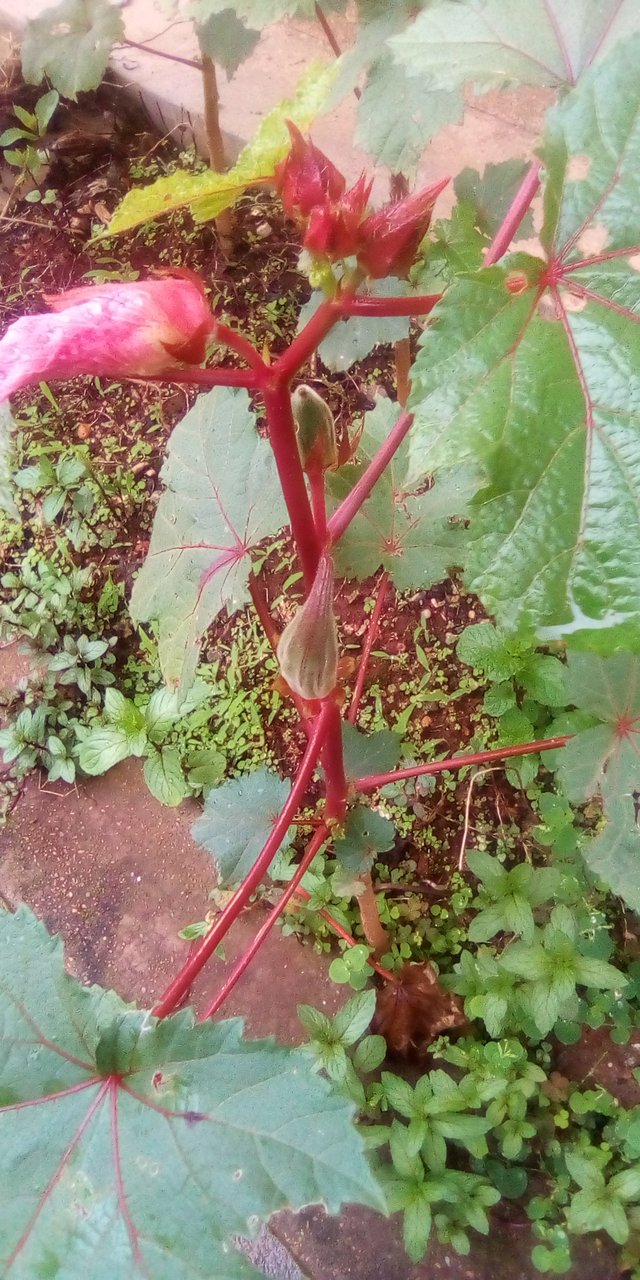
Okra or Okro Abelmoschus esculentus, known in many English-speaking countries as ladies' fingers or ochro, is a flowering plant in the mallow family. It is valued for its edible green seed pods. It is a good source of minerals, vitamins, antioxidants, and fiber.The geographical origin of okra is disputed, with supporters of West African, Ethiopian, and South Asian origins. As a result of the Trans-Atlantic Slave Trade, Okra is a southern U.S plant that thrives in relatively warmer temperatures. It is also easy to grow. As a result, the plant is cultivated in tropical, subtropical and warm temperate regions around the world.
Stir-fried okra with diced chili peppers
The products of the plant are mucilaginous, resulting in the characteristic "goo" or slime when the seed pods are cooked; the mucilage contains soluble fiber.One possible way to de-slime okra is to cook it with an acidic food, such as tomatoes, to render the mucilage less viscous. Pods are cooked, pickled, eaten raw, or included in salads. Okra may be used in developing countries to mitigate malnutrition and alleviate food insecurity.
Though classified as a fruit, Okra has often been utilized as a vegetable, both on its own and with other dishes and materials. When cooked, it takes many forms. Cutting and cooking okra in moisture will create a sticky juice that increases the thickness of soups and stews. Dried okra can also thicken sauces. Some people sometimes use it as an egg white substitute to increase richness of flavor. Other people might grind and roast the seeds as a non-caffeinated substitute.
Raw okra is 90% water, 2% protein, 7% carbohydrates and negligible in fat. In a 100 gram amount, raw okra is rich (20% or more of the Daily Value, DV) in dietary fiber, vitamin C and vitamin K, with moderate contents of thiamin, folate and magnesium (table). Okra also provides iron, niacin, phosphorus, copper, and a rich source of antioxidants.
Young okra leaves may be cooked in a similar way to the greens of beets or dandelions, or in salads.[citation needed] Okra seeds may be roasted and ground to form a caffeine-free substitute for coffee. When importation of coffee was disrupted by the American Civil War in 1861, the Austin State Gazette said, "An acre of okra will produce seed enough to furnish a plantation with coffee in every way equal to that imported from Rio."
Greenish-yellow edible okra oil is pressed from okra seeds; it has a pleasant taste and odor, and is high in unsaturated fats such as oleic acid and linoleic acid.The oil content of some varieties of the seed is about 40%. At 794 kg/ha, the yield was exceeded only by that of sunflower oil in one trial.A 1920 study found that a sample contained 15% oil.A 2009 study found okra oil suitable for use as a biofuel.
Bast fibre from the stem of the plant has industrial uses such as the reinforcement of polymer composites. The mucilage produced by the okra plant can be used for the removal of turbidity from wastewater by virtue of its flocculant properties.Having composition similar to a thick polysaccharide film, okra mucilage is under development as a biodegradable food packaging, as of 2018.
There is ongoing research about the different uses of Okra. According to a study done by researchers from Hainan Medical College exploring the effect of okra extract on gestational diabetes mellitus (GDM) rats and its probable molecular mechanism, Okra can improve the blood sugar levels of pregnant rats that had gestational diabetes. Okra is also high in fiber. About eight medium-sized pods are estimated to contain 3 grams of fiber. According to a study done by researchers Hiroki Fujii, Masanori Iwase, Toshiaki Ohkuma Shinako Ogata-Kaizu, et al. that explores the impact of dietary fiber intake on glycemic control, cardiovascular risk factors and chronic kidney disease in Japanese patients with type 2 diabetes mellitus, Okra increases fiber intake promotes better glycemic control and improves insulin sensitivity. According to a study done by researchers Sathish Kumar Doreddula, Srinivasa Reddy Bonam, Durga Prasad Gaddam, et al. on "Phytochemical Analysis, Antioxidant, Antistress, and Nootropic Activities of Aqueous and Methanolic Seed Extracts of Ladies Finger (Abelmoschus esculentus L.) in Mice", Okra seed extracts of okra have an antioxidant, anti-stress effect in the bloodstream of mice.And food that has high fiber content and antioxidants lower cholesterol levels, according to The American Heart Association. According to another study done by researchers Fangbo Xia, Yu Zhong, Mengqiu Li, Qi Chang, et al. on "Antioxidant and Anti-Fatigue Constituents of Okra", Okra plants can improve recovery times and fatigue levels. Thus, if one includes Okra in their daily diet, one might be able to work for longer hours and recover more quickly from fatigue.